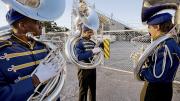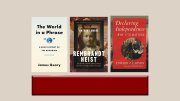Interop, by John Palfrey ’94, J.D. ’01, and Urs Gasser, LL.M. ’03 (Basic Books, $28.99). Palfrey, formerly of the Law School and now headmaster of Phillips Academy Andover, and Gasser, executive director of the Berkman Center for Internet & Society, advance a theory for optimum interoperability, to achieve “the promise and perils of highly interconnected systems” (their subtitle)—yielding, say, better medical records and averting invasions of privacy and other disasters.
We Shall Not Be Moved, by Tom Wooten ’08 (Beacon Press, $25.95). The title is literal: narratives of the community leaders who stayed in and worked to rebuild New Orleans neighborhoods in the wake of Hurricane Katrina.
Restoring Trust in Organizations and Leaders, edited by Roderick M. Kramer and Todd L. Pittinsky (Oxford, $59.99). A pair of social scientists solicited colleagues’ views, in writing and via a Harvard Kennedy School conference, on the “dramatic and deeply troubling decline in trust” in entities and people, private and public. Many of the respondents are leading Harvard professors, including Iris Bohnet and Richard Zeckhauser (Kennedy School), Amy Edmondson (Business), and Howard Gardner (Education).
Nuclear Forces, by Silvan S. Schweber (Harvard, $35). The author, an associate of the department of the history of science (and an emeritus professor at Brandeis), examines in depth the early life and development of Hans Bethe, the towering physicist whose work subsequently led him both to help develop and then to denounce the atomic bomb.
Jobs for the Boys: Patronage and the State in Comparative Perspective, by Merilee S. Grindle, Mason professor of international development (Harvard, $45). The author, director of the David Rockefeller Center for Latin American Studies, examines patronage as a centuries-old system of public service in developed and developing nations, in contrast to the merit-based (and purportedly corruption-free) systems intended to supplant it.
America the Philosophical, by Carlin Romano (Knopf, $35). Is the title a joke, like “Canada the Exhibitionist”? asks the author, a professor at Ursinus, columnist, and critic. He then argues, brilliantly and at length, that it is not, along the way invoking all the Harvard giants: James, Peirce, Santayana, Rawls, Quine, Nozick, Skinner, et cetera.
The Annotated Brothers Grimm, edited by Maria Tatar, Loeb professor of Germanic languages and literatures and of folklore and mythology (W.W. Norton, $39.95). Revealingly annotated and beautifully illustrated, for the bicentennial.
Why We Are Here: Mobile and the Spirit of a Southern City, by Edward O. Wilson, Pellegrino University Professor emeritus, and Alex Harris (Liveright, $39.95). Naturalist Wilson’s memoir of his Alabama family and childhood, and of the downs and ups of his emotional home, is beautifully accompanied by the Duke documentary photographer’s images.
Renaissance Gothic, by Ethan Matt Kavaler ’80 (Yale, $75). A scholarly, sumptuously illustrated consideration of the late Gothic in such iconic monuments as King’s College, Cambridge, that disentangles the style from the Italian Renaissance. The author is professor of art history at the University of Toronto.
Regenesis: How Synthetic Biology Will Reinvent Nature and Ourselves, by George Church, Winthrop professor of genetics, and Ed Regis (Basic Books, $28). An enthusiastic report on the potential for, say, engineering susceptibility to viruses out of humans, by one of the world’s leading genomic scientists and a coauthor. Food for thought, in the transition from “Genesis” to “gene” science to the deliberate shaping of evolution.
A Year Up, by Gerald Chertavian, M.B.A. ’92 (Viking, $26.95). The founder and CEO of Year Up explicates how to cross the “opportunity divide” that keeps disadvantaged youth off, or far down on, the job ladder; his organization provides a structured year of training and mentorship meant to get them to higher rungs.
Julian Bell: From Bloomsbury to the Spanish Civil War, by Peter Stansky, Ph.D. ’61, and William Abrahams ’41 (Stanford, $45). The two authors wrote four books together, including an earlier assessment of Bell, in Journey to the Frontier. Now, Stansky, a Stanford historian, has revisited the Bloomsbury poet, drawing on new archives; he retains Abrahams, an acclaimed editor, as coauthor, 13 years after his death.
The World Without You, by Joshua Henkin ’87 (Pantheon, $25.95). The author’s third novel, set in 2005, draws upon the murder of journalist Daniel Pearl in Pakistan, but focuses on its fictional family’s loss, not on geopolitics and terrorism. Critic Adam Kirsch ’97 calls the author a “novelist of distinguished gifts.”









